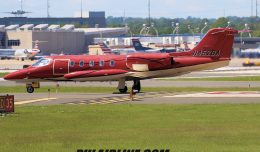EDITOR’S NOTE: The following is an independent analysis and is in no way an official investigation.
FACTS FROM VIDEO
– Aircraft had a very low forward airspeed during the stall and on impact.
– The landing gear was down.
– Engines emit smoke just before the stall.
– Flaps were in a takeoff position.
– There were vapor trails from the wing tips. horizontal stabilizer, and engine pylons as the aircraft lost altitude.
– Engines shoot forward on impact approximately 200 feet.
– Left wing dips at the beginning of the stall, followed by a rotation to the right that ends when the bank angle approaches 90 degrees.
– The fire indicates there was a light right headwind/crosswind.
ANALYSIS
Informal analysis: (based on observations, assumptions, and deductions). Note, investigators will be reviewing all evidence, and the conclusions will be more soundly reasoned than this analysis based solely on the video footage.
The fact that the gear was down indicates that the crew was experiencing problems immediately after takeoff that focused their attention elsewhere. From the video, you can see the aircraft’s speed was deteriorating. There is a transient smoke stream from the engines just before the stall, which is an indication of an acceleration of the engine core’s RPM – the crew were likely firewalling the throttles. There was a light dip of the left wing at the beginning of the stall. The pilot likely countered with right rudder, a correct but excessive input that caused the aircraft to enter a spin to the right. At this point, airspeed appears to be nearly undetectable but probably around 100 knots.
Swept wing aircraft, especially ones with high angles of sweep like the 747, pitch up at the last moment of a stall before the nose drops and airspeed is recovered. In the video, the nose does not drop until the aircraft is on its side and rapidly loosing altitude. Once the aircraft is on a knife-edge, the airflow will cause the vertical stabilizer to weathervane. This brings the nose down. During this time, the right rotation also stops. If there had been an engine failure, the rotation would have continued in the direction of the failed engine. As the wings are brought level, the nose down attitude remains stable through impact. At this point, there are vapor trails from the horizontal stabilizers and wing. This indicates a high pressure differential which is clearly from the high angles of attack on the surfaces.
The crew had a controllability problem that was present from rotation. Pilot training and instinct is to lower the nose if the aircraft is pitching up. This wasn’t possible. To put this aircraft in the position it was would have required excessive nose up elevator or excessive rear Center of Gravity (CG). Since this was a routine flight and the aircraft had not likely had major maintenance causing a critical failure of the flight controls, a rear CG is the likely problem.
This is also indicated on the final moments prior to impact. Had the CG been in the proper location, the nose down pitch would have continued as the CG forward of the wing’s lift would have accelerated towards the earth from gravity while the wing resisted this acceleration due to airflow (drag) on the wing, even with a major failure of the trim or elevator. Just prior to impact, the pitch remains mostly stable, indicating the CG was between the wing and tail, and the weight on each was proportional to the lift being generated. The proportion of the surface area of the wing to tail surface would be equal and inversely proportion of the CG between them. Ie, if the surface area was 70% wing and 30% tail, the CG would be 30% back from the wing, or 70% forward of the tail.
There are many other possibilities, example pilot error. Though this is unlikely, these must be considered until conclusively found otherwise.







